2003 HONDA ODYSSEY height
[x] Cancel search: heightPage 21 of 415
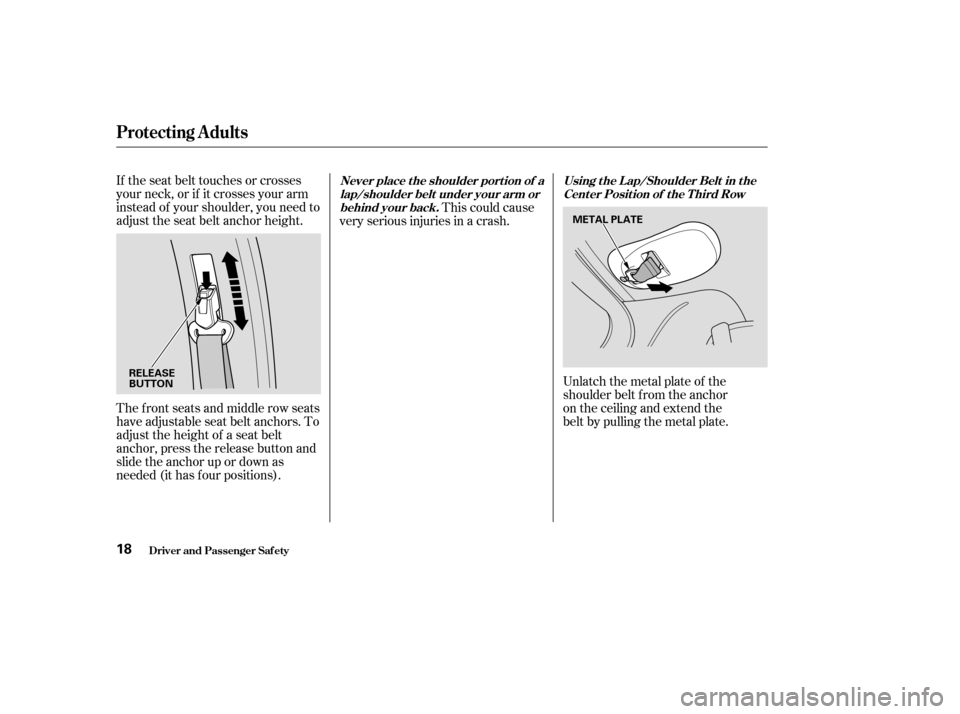
If the seat belt touches or crosses
your neck, or if it crosses your arm
instead of your shoulder, you need to
adjust the seat belt anchor height.
The f ront seats and middle row seats
have adjustable seat belt anchors. To
adjust the height of a seat belt
anchor, press the release button and
slide the anchor up or down as
needed (it has f our positions).This could cause
very serious injuries in a crash.
Unlatch the metal plate of the
shoulder belt f rom the anchor
on the ceiling and extend the
belt by pulling the metal plate.
Driver and Passenger Saf ety
Protecting Adults
Never place t he shoulder port ion of alap/shoulder belt under your arm orbehind your back. Using t he L ap/Shoulder Belt in t he
Cent er Posit ion of t he T hird Row
18
RELEASE
BUTTON METAL PLATE
Page 37 of 415
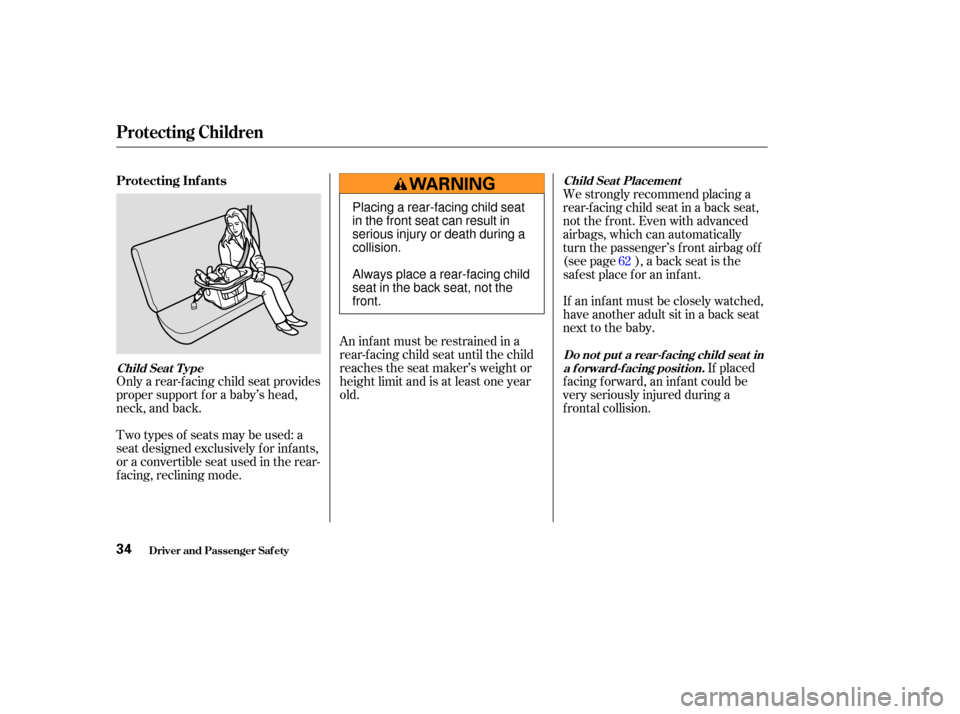
Only a rear-f acing child seat provides
proper support f or a baby’s head,
neck, and back.
Two types of seats may be used: a
seat designed exclusively f or inf ants,
or a convertible seat used in the rear-
f acing, reclining mode.An inf ant must be restrained in a
rear-f acing child seat until the child
reaches the seat maker’s weight or
height limit and is at least one year
old.We strongly recommend placing a
rear-facing child seat in a back seat,
not the front. Even with advanced
airbags, which can automatically
turn the passenger’s f ront airbag of f
(see page ), a back seat is the
saf est place f or an inf ant.
If an inf ant must be closely watched,
have another adult sit in a back seat
next to the baby.
If placed
f acing f orward, an inf ant could be
very seriously injured during a
f rontal collision. 62
Protecting Inf ants
Child Seat T ype Child Seat Placement
Do not put a rear-f acing child seat ina f orward-f acing position.
Protecting Children
Driver and Passenger Saf ety34
Placing a rear-facing child seat
in the front seat can result in
serious injury or death during a
collision.
Always place a rear-facing child
seat in the back seat, not the
front.
Page 41 of 415
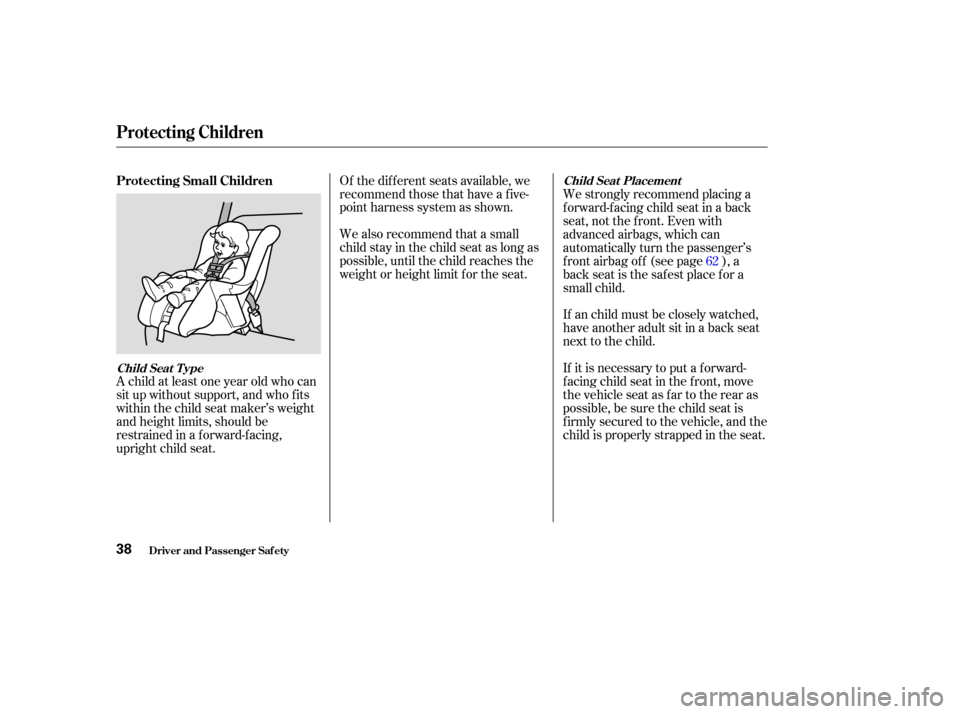
We also recommend that a small
child stay in the child seat as long as
possible, until the child reaches the
weight or height limit f or the seat. Of the different seats available, we
recommend those that have a f ive-
point harness system as shown.
A child at least one year old who can
sit up without support, and who f its
within the child seat maker’s weight
and height limits, should be
restrained in a f orward-f acing,
upright child seat. We strongly recommend placing a
forward-facing child seat in a back
seat,notthefront.Evenwith
advanced airbags, which can
automatically turn the passenger’s
front airbag off (see page ), a
back seat is the safest place for a
small child.
If an child must be closely watched,
have another adult sit in a back seat
next to the child.
If it is necessary to put a f orward-
f acing child seat in the f ront, move
the vehicle seat as far to the rear as
possible, be sure the child seat is
f irmly secured to the vehicle, and the
child is properly strapped in the seat.
62
Protecting Small Children
Child Seat T ype Child Seat Placement
Protecting Children
Driver and Passenger Saf ety38
Page 45 of 415
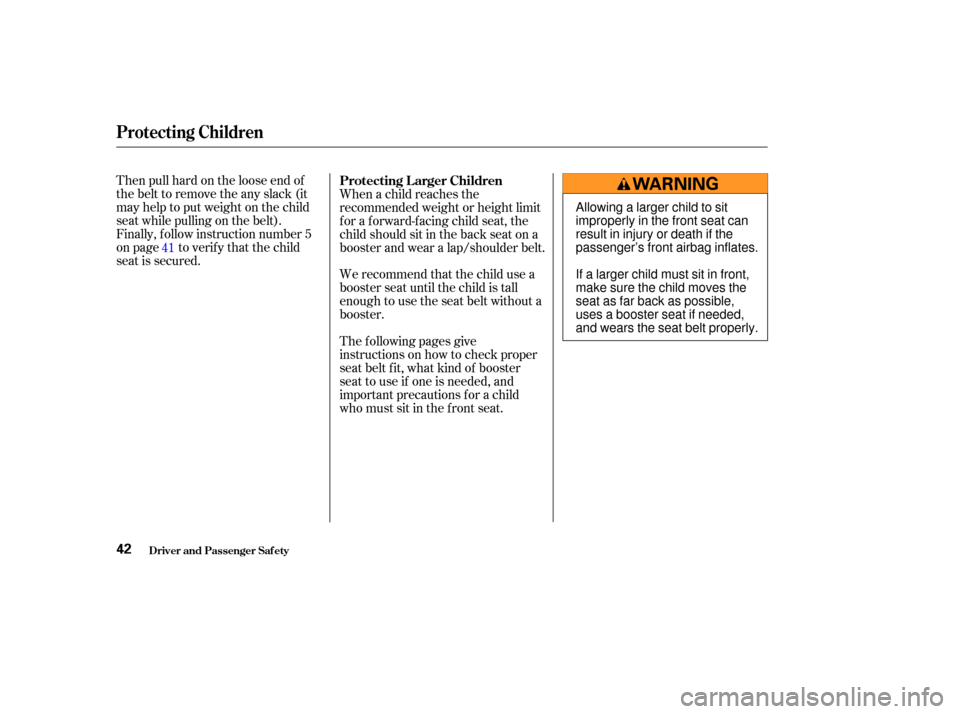
Then pull hard on the loose end of
thebelttoremovetheanyslack(it
may help to put weight on the child
seat while pulling on the belt).
Finally, f ollow instruction number 5
on page to verify that the child
seat is secured.When a child reaches the
recommended weight or height limit
for a forward-facing child seat, the
child should sit in the back seat on a
booster and wear a lap/shoulder belt.
We recommend that the child use a
booster seat until the child is tall
enough to use the seat belt without a
booster.
The f ollowing pages give
instructions on how to check proper
seat belt f it, what kind of booster
seat to use if one is needed, and
important precautions f or a child
who must sit in the f ront seat.
41
Protecting L arger Children
Protecting Children
Driver and Passenger Saf ety42
Allowing a larger child to sit
improperly in the front seat can
result in injury or death if the
passenger’s front airbag inflates.
If a larger child must sit in front,
make sure the child moves the
seat as far back as possible,
uses a booster seat if needed,
and wears the seat belt properly.
Page 47 of 415
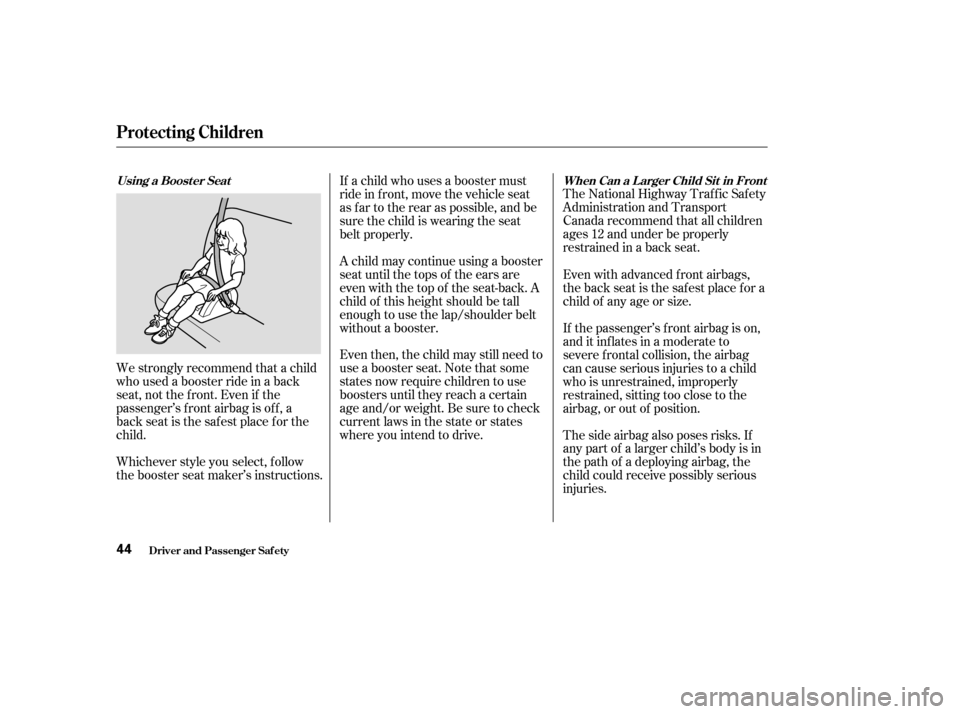
The National Highway Traffic Safety
Administration and Transport
Canada recommend that all children
ages 12 and under be properly
restrained in a back seat.
We strongly recommend that a child
whousedaboosterrideinaback
seat,notthefront.Evenif the
passenger’s f ront airbag is of f , a
back seat is the safest place for the
child.
Whichever style you select, f ollow
the booster seat maker’s instructions. If a child who uses a booster must
ride in f ront, move the vehicle seat
as far to the rear as possible, and be
sure the child is wearing the seat
belt properly.
A child may continue using a booster
seat until the tops of the ears are
even with the top of the seat-back. A
child of this height should be tall
enough to use the lap/shoulder belt
without a booster.
Even then, the child may still need to
use a booster seat. Note that some
states now require children to use
boosters until they reach a certain
ageand/orweight.Besuretocheck
current laws in the state or states
where you intend to drive.
If the passenger’s f ront airbag is on,
and it inflates in a moderate to
severe f rontal collision, the airbag
can cause serious injuries to a child
who is unrestrained, improperly
restrained, sitting too close to the
airbag, or out of position.
The side airbag also poses risks. If
any part of a larger child’s body is in
the path of a deploying airbag, the
child could receive possibly serious
injuries. Even with advanced front airbags,
the back seat is the safest place for a
child of any age or size.
When Can a Larger Child Sit in Front
Using a Boost er Seat
Protecting Children
Driver and Passenger Saf ety44
Page 72 of 415

This section gives inf ormation about
the controls and displays that
contribute to the daily operation of
your Honda. All the essential
controls are within easy reach............................
Control Locations .70
...............................
Indicator Lights .71
.............................................
Gauges .78
Controls Near the Steering .......................................
Wheel .81
...................................
Headlights .82
Automatic Lighting Off .....................................
Feature .83
............
Daytime Running Lights . 83
....
Instrument Panel Brightness . 83
................................
Turn Signals .84 .....................
Windshield Wipers .84
..................
Windshield Washers . 86
Rear Window Wiper and .....................................
Washer .86
..........................
Hazard Warning .87
.............
Rear Window Def ogger . 87
......
Steering Wheel Adjustment . 88
...............................
Keys and Locks .89
..............................................
Keys .89
....................
Immobilizer System . 90
............................
Ignition Switch .91
......................
Power Door Locks .92
...................
Remote Transmitter . 94
..............
Childproof Door Locks . 98
........................................
Tailgate .98
..................................
Glove Box .100
...................
Manual Sliding Doors . 101
.....................
Power Sliding Doors .103
...............................................
Seats .109
....................
Passenger Seating .109
......................
Seat Adjustments .110
Driver’s Seat Manual Height ............................
Adjustment .112
Driver’s Seat Power ..........................
Adjustments .113
.........
Driver’s Lumbar Support . 114....................................
Armrests .115
........................
Head Restraints .115
.....................
Third Seat Access .116
Moving the Second Row ...........................
Bucket Seat .117
Removing the Bucket Seats ................
in the Second Row . 119
Folding the Third Row .........................
‘‘Magic Seat’’ .120
..................................
Seat Heaters .123
............................
Power Windows .124
...........................................
Mirrors .128
...............................
Parking Brake .129
..................................
Digital Clock .130
..................................
Center Table .130
.........................
Beverage Holders .132
........................
Sunglasses Holder .134
........................................
Sun Visor .134
................................
Vanity Mirror .135
.......................
Rear Compartment .135
...............................
Center Pocket .136
...................................
Coin Holder .136
...................................
Storage Box .137
......................................
Coat Hook .137
............
Accessory Power Sockets . 138
...............................
Interior Lights .139
Instruments and Controls
Inst rument s and Cont rols69
Page 115 of 415
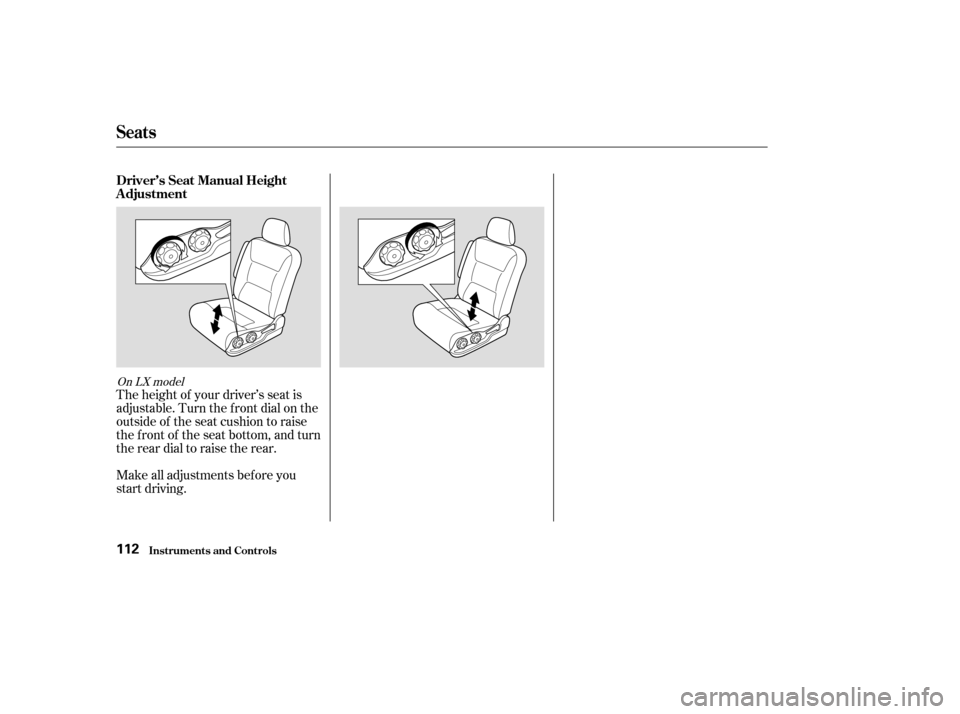
Make all adjustments bef ore you
start driving. The height of your driver’s seat is
adjustable. Turn the front dial on the
outside of the seat cushion to raise
the front of the seat bottom, and turn
the rear dial to raise the rear.
On LX model
Driver’s Seat Manual Height
Adjustment
Seats
Inst rument s and Cont rols112
Page 118 of 415
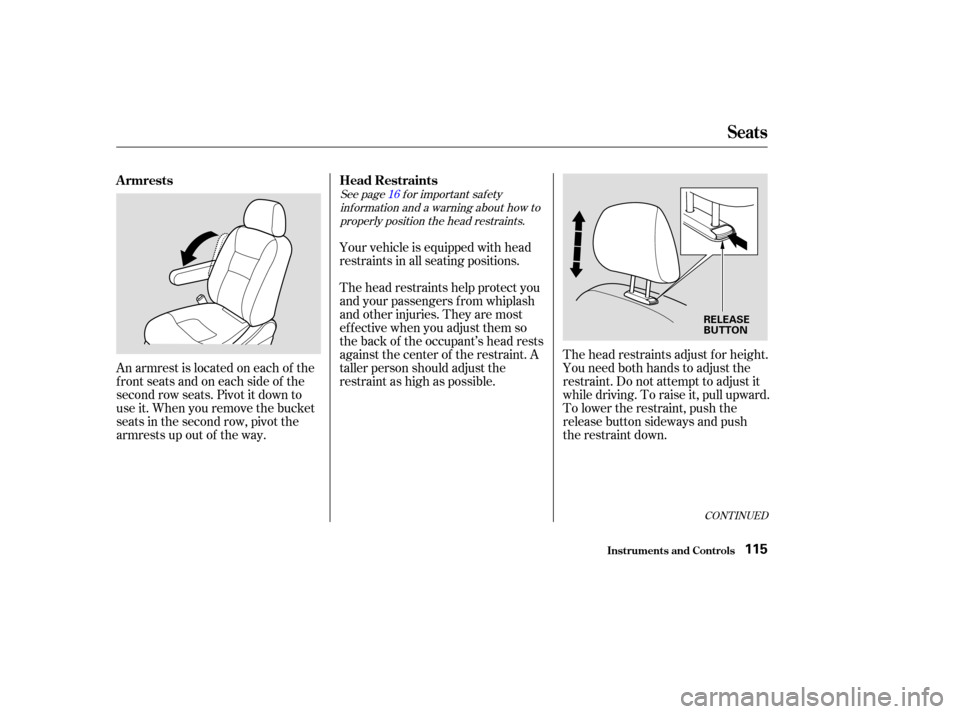
The head restraints adjust f or height.
You need both hands to adjust the
restraint.Donotattempttoadjustit
while driving. To raise it, pull upward.
To lower the restraint, push the
release button sideways and push
the restraint down.
Your vehicle is equipped with head
restraints in all seating positions.
The head restraints help protect you
and your passengers f rom whiplash
and other injuries. They are most
ef f ective when you adjust them so
the back of the occupant’s head rests
against the center of the restraint. A
taller person should adjust the
restraint as high as possible.
An armrest is located on each of the
frontseatsandoneachsideof the
second row seats. Pivot it down to
use it. When you remove the bucket
seats in the second row, pivot the
armrests up out of the way.
See page f or important saf ety
inf ormation and a warning about how toproperly position the head restraints. 16
CONT INUED
Head Restraints
Armrests
Seats
Inst rument s and Cont rols115
RELEASE
BUTTON